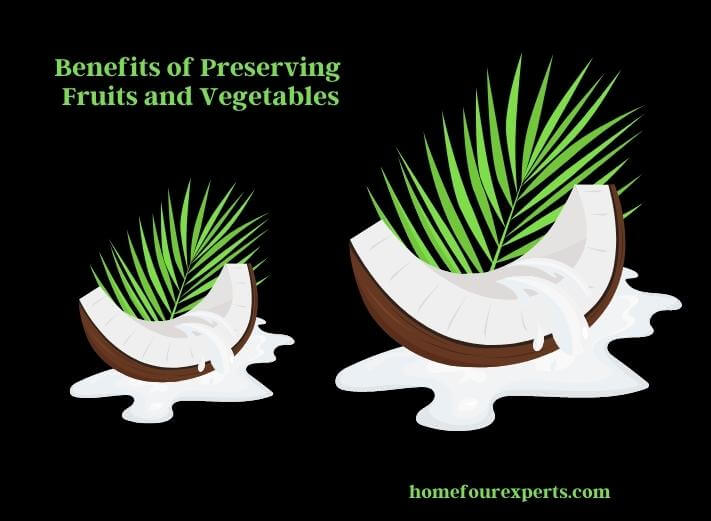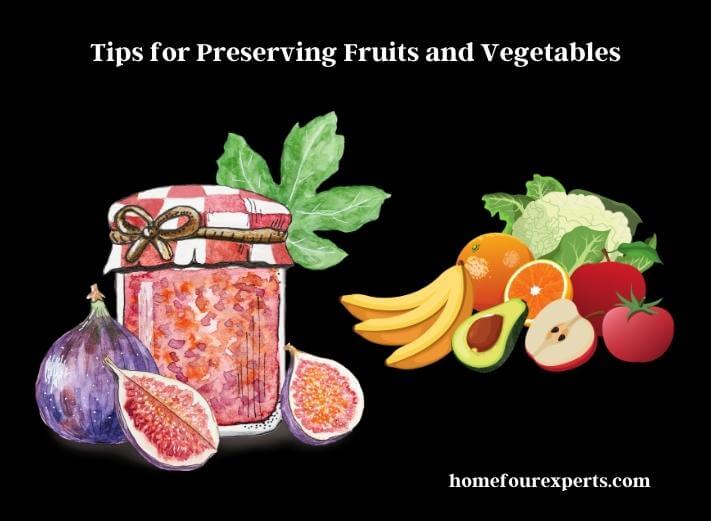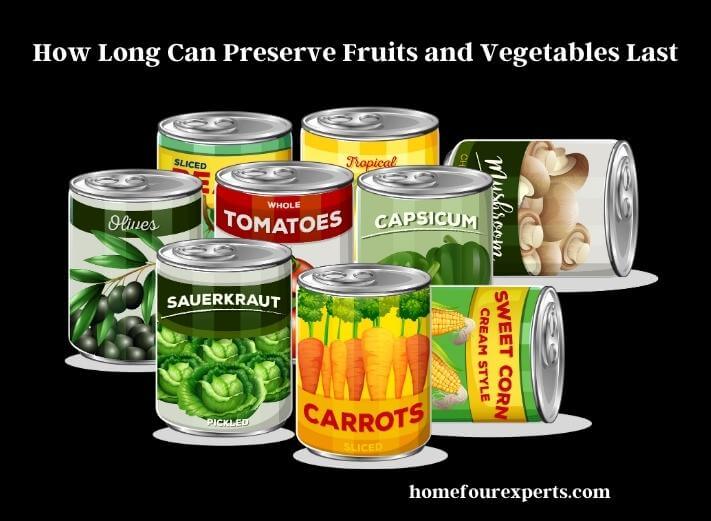Eating a healthy and balanced diet is essential for our overall health and well-being. One way to ensure that we’re getting all the nutrients we need is by incorporating plenty of fruits and vegetables into our meals.

It can be challenging to keep produce fresh for an extended period. This is where preserving fruits and vegetables come in handy. Not only does it help to prevent food waste, but it also allows us to enjoy fresh, nutritious produce all year round.
Benefits of Preserving Fruits and Vegetables
Preserving fruits and vegetables has numerous benefits, including:
- Cost-saving: Buying produce in bulk when it is in season and preserving it for later can save you money in the long run.
- Convenience: Preserving your product allows you to have access to fresh fruits and vegetables throughout the year, even when they are out of season.
- Nutrient retention: Properly preserved fruits and vegetables can retain their nutritional value for an extended period.

Methods of Preservation
There are several methods of preserving fruits and vegetables, including:
Canning
Canning involves heating and sealing fruits and vegetables in airtight jars. This method can preserve produce for up to 1-2 years and is suitable for low-acid foods like vegetables, meat, and fish.
Freezing
Freezing involves storing fruits and vegetables at very low temperatures to prevent spoilage. This method can preserve produce for up to 8-12 months and is suitable for most fruits and vegetables.
Dehydrating
Dehydrating involves removing the water content from fruits and vegetables to prevent bacterial growth. This method can preserve produce for up to 1 year and is suitable for fruits and vegetables with low water content, like apples and carrots.
Pickling
Pickling involves immersing fruits and vegetables in an acidic solution to prevent spoilage. This method can preserve produce for up to 1 year and is suitable for vegetables like cucumbers and carrots.
Tips for Preserving Fruits and Vegetables
Preserving Fruits
Freezing:
Freezing is an excellent method for preserving fruits. Here’s how you can do it:
- Wash and dry the fruits.
- Cut the fruits into pieces or leave them whole.
- Pack the fruits in airtight containers or freezer bags.
- Label and date the containers.
- Place them in the freezer.

Drying:
Drying is another great way to preserve fruits. Here’s what you need to do:
- Wash and dry the fruits.
- Slice the fruits thinly.
- Arrange them on a baking sheet lined with parchment paper.
- Preheat the oven to 140°F and bake for 6-12 hours.
- Once dried, store the fruits in an airtight container.
Canning:
Canning is a method that involves heating and sealing the fruits in jars. Here’s how to can fruits:
- Wash and dry the fruits.
- Cut the fruits into pieces or leave them whole.
- Add the fruits to a jar.
- Add sugar or syrup if desired.
- Place the jar in boiling water for the specified time.
- Remove the jar from the water and let it cool.
- Check the seal and store the jars in a cool, dry place.
Preserving Vegetables
Freezing:
Freezing is a great way to preserve vegetables. Here’s how to do it:
- Wash and dry the vegetables.
- Blanch the vegetables by boiling them for a few minutes.
- Immediately place the vegetables in ice-cold water.
- Dry the vegetables and pack them in airtight containers or freezer bags.
- Label and date the containers.
- Place them in the freezer.
Pickling:
Pickling involves preserving vegetables in vinegar or brine. Here’s what you need to do:
- Wash and dry the vegetables.
- Cut the vegetables into the desired size and shape.
- Add the vegetables to a jar.
- Add vinegar or brine.
- Add herbs and spices if desired.
- Seal the jar and store it in a cool, dry place.
Canning:
Canning is also an excellent method for preserving vegetables. Here’s how to do it:
- Wash and dry the vegetables.
- Cut the vegetables into pieces or leave them whole.
- Add the vegetables to a jar.
- Add salt or vinegar if desired.
- Place the jar in boiling water for the specified time.
- Remove the jar from the water and let it cool.
- Check the seal and store the jars in a cool, dry place.
Using Preserved Fruits and Vegetables for Nutritious Meals
Preserved fruits and vegetables can be used in various dishes to add flavor, texture, and nutrition. Here are some ways to use them:
- Smoothies: Frozen fruits and vegetables can be blended to make nutritious and delicious smoothies.
- Soups and stews: Canned vegetables like tomatoes, corn, and beans can be used in soups and stews.
- Sauces and spreads: Pickled vegetables can be used to make tangy sauces and spreads.
- Baked goods: Dehydrated fruits like raisins and dried apricots can be used in baked goods like muffins and cakes.
How Long Can Preserve Fruits and Vegetables Last?
The shelf life of preserved fruits and vegetables can vary depending on the preservation method used and how well the produce was prepared and stored. Generally, frozen fruits and vegetables can last up to 8-12 months in the freezer.

Dried fruits and vegetables can last for several months to a year when stored in an airtight container in a cool, dry place. Canned fruits and vegetables can last up to 1-2 years when stored in a cool, dark place. However, it is important to always check for signs of spoilage, such as mold or off odors, before consuming any preserved produce. If in doubt, it is best to discard the product to avoid any potential foodborne illness.
If you want to know the art of making cheese, Read here for the process.
Wrap Up
Preserving fruits and vegetables is an excellent way to enjoy nutritious meals all year round while saving money and reducing food waste. With various preservation methods available, there is a preservation technique suitable for every type of produce and personal preference. Preserving fruits and vegetables helps to retain their nutritional value, making them a great addition to any healthy diet.
If you take the time to learn about the different preservation methods and invest in the right equipment, you can easily preserve your favorite fruits and vegetables for future use. Remember to always follow proper food safety guidelines when preserving produce, and avoid preserving fruits and vegetables that are past their prime.
Incorporating preserved fruits and vegetables into your meals can add flavor, nutrition, and convenience to your diet, making it easier to maintain a healthy lifestyle. So, whether you are a seasoned preserver or just starting, consider preserving fruits and vegetables to enjoy delicious, healthy meals year-round.
Common Questions & Response
What Fruits and Vegetables Can Be Preserved?
Almost all fruits and vegetables can be preserved using various methods. Some common fruits and vegetables that are often preserved include berries, apples, pears, peaches, cherries, tomatoes, cucumbers, carrots, green beans, and peppers. There are many other types of products that can be preserved as well, depending on personal preference and availability.
Can Preserved Fruits and Vegetables Be Used for Cooking?
Yes, preserved fruits and vegetables can be used in various recipes, including smoothies, soups, stews, and casseroles. The preserved produce can add flavor, texture, and nutrients to dishes throughout the year. Just be sure to adjust cooking times and seasonings accordingly, as the preserved fruits and vegetables may have a different texture and taste than fresh produce.
Do Preserved Fruits and Vegetables Lose Their Nutritional Value?
Preserved fruits and vegetables can lose some of their nutritional value depending on the preservation method used. Proper preservation techniques can help retain a significant amount of nutrients.
About This Writer

Hi, I am Eric Devin and I am a professional interior architect. Since childhood, I've always enjoyed DIY projects! And, I have loved to solve simple household problems using essential tools and equipment. I have also acquired a lot of information about basic household tools settings by working with contractors.